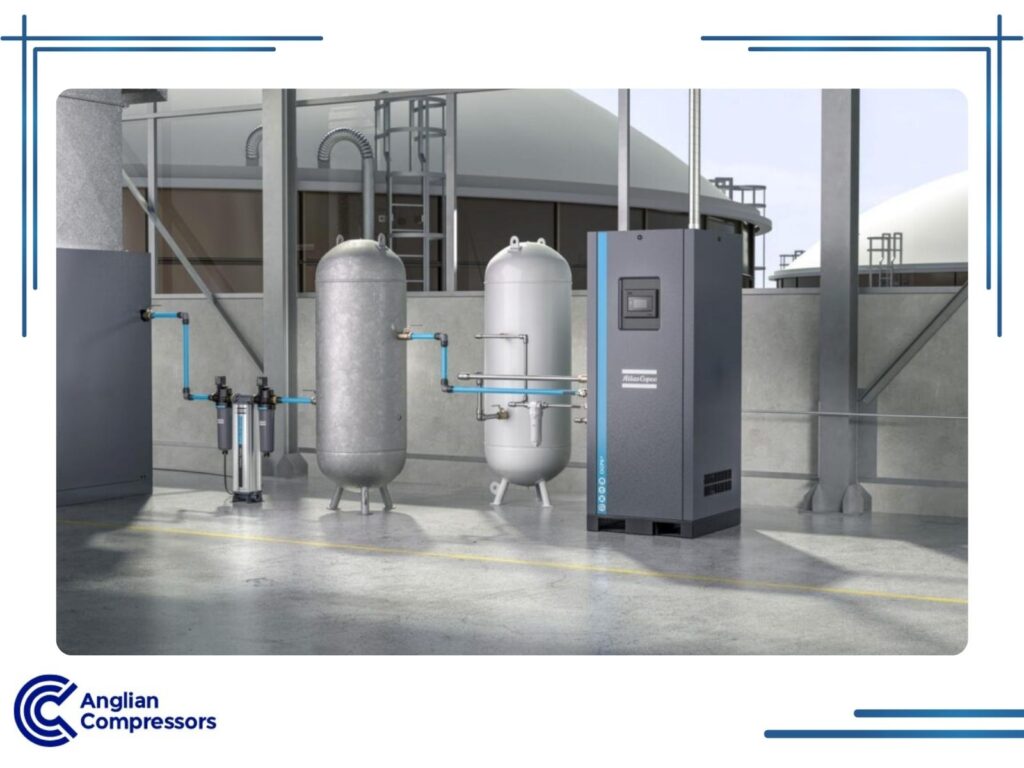Benefits of On-site Gas Generation
All types of operations depend on gas, including offshore drilling, food production, beverage bottling, semiconductor production, and industries using laser cutting. Businesses using bottled nitrogen must deal with storage tank management, uncertain gas availability, long contracts, variable pricing, and hefty delivery charges.
On-site gas generation, such as nitrogen gas, is an affordable alternative to having nitrogen delivered. Membrane generators are a good option because of their small footprint, low noise emissions, and energy efficiency.
Here are 7 benefits of on-site gas generation.
Table of Contents
1. 24/7 Availability
Nitrogen stored on-site prior to use sounds like a good idea. However, one error in the usage calculation and/or a lack of monitoring of on-site supplies and production gets halted. Suddenly, the company runs short of the necessary nitrogen for its operations. A new order and a liquid nitrogen delivery are days away…
Instead, with on-site nitrogen generation, it’s available 24/7. Air is already composed of almost 80% nitrogen. A membrane generator processes ambient air and cleanly extracts the nitrogen from it. Then delivers it at the right purity level.
2. Safer Work Environment
Managing the delivery and unloading process for replacement nitrogen supplies is problematic. Space is needed to store bottles or cylinders, and there’s always the possibility of worker injury. A trapped toe or a foot, or worse, a nitrogen gas cylinder falling onto someone, often leads to injuries.
Before transportation, nitrogen gas must be converted to a liquid state and be highly pressurised (200 bar or more). Unloading cylinders containing highly pressurized liquid gas poses considerable safety risks. Given that companies have serious responsibilities regarding the health and safety of all staff members, avoiding the need to interact with bottled nitrogen is beneficial.
The latest Atlas Copco nitrogen generators allow staff to avoid exposure to liquid nitrogen gas, removing the potential for serious burns or other injuries. Installed generator systems minimise direct operator involvement, making the nearby working area safer.
3. Reduced Carbon Footprint
Industrial companies are keen to reduce their carbon footprint. Being seen as environmentally friendly is essential when pursuing greener business practices. This applies whether operating a lab, managing a brewery, or packaging food as a food processor.
Sidestepping a supply chain dependence on regularly delivered bottled nitrogen keeps delivery vehicles off the road. This reduces the company’s carbon footprint in a meaningful way. For a manager responsible for their facility’s environmental impact, it’s an easy win-win.
Also, using gas deliveries means converting gas to a liquid state for transportation, and then returning it to a gaseous state post-delivery. Both processes use energy and other resources wastefully, which affects the environment.
Onsite nitrogen generation avoids these types of unnecessary conversions altogether.
4. Cost Savings
The cost of delivered liquid nitrogen is considerable. It is often too highly pressurised, which increases the expense too. Also, it’s helpful to know that storage tank leaks result in approximately 10 per cent of gas lost during transit. Companies pay for what someone originally loaded into the tanks, not what arrived inside them, so they lose out.
Additionally, relying on a gas company, using a storage tank, and needing to constantly manage supplies takes up administration time too.
On-site nitrogen generators do away with nitrogen gas cylinders and continual storage requirements. Gas is produced only when required. Note that the latest Atlas Copco nitrogen generators spin up in seconds – membrane generators outperform in this regard. There is no wasted supply, unlike the remaining gas in an almost-empty gas bottle.
Instead, investing in the on-site generation of your own nitrogen using compressed air systems ensures that the nitrogen supply is cost-efficient. Depending on how much nitrogen was previously ordered for delivery, cost savings from generator-based systems can be net positive in a few years.
5. Control the Purity
Purity levels are a major concern for nitrogen users. Depending on the purpose and machinery utilising the nitrogen, a certain purity level is required. Regrettably, delivered nitrogen often arrives over specified. Here, businesses pay for a higher level of pressurisation than necessary and pay the price for the privilege.
By opting for onsite nitrogen generation, your staff controls the purity level directly from the generator’s control panel. With membrane generators, purity is achievable up to approximately 99.9% or so. However, when exacting requirements necessitate a 99.999% purity, then only a pressure swing adsorption generator will do.
6. Save Floor Space
Holding a gas storage tank or multiple standing gas cylinders on the premises takes up floor space. This space is better utilised by machinery or used for other purposes.
An unhappy trade-off is necessary between the amount of nitrogen gas stored versus the space it occupies. The intention is to avoid ever completely running out of gas for production. Many times, the gas cylinders are rented, too. So, there’s financial pressure not to have too many full tanks sitting around before they’re used.
While the onsite gas generation equipment clearly takes up floor space, the equipment itself is compact. There are no awkward deliveries to contend with or pesky storage issues. Nitrogen is no longer a headache to deal with.
7. Improve Existing Industrial Processes by switching to Nitrogen
In some situations, it’s possible to use nitrogen as a replacement. This may be optimal from a production or a financial cost standpoint but wasn’t considered sensible when not having direct control over the production of necessary gasses.
One example of this is breweries that previously used oxygenation in their processes but later switched to nitrogenation instead. This got around supply bottlenecks of CO2 and potential price spikes that play havoc with raw material estimates within management accounts. It also lowered the carbon footprint too.

Let Anglian Compressors Offer Guidance
Making a change from nitrogen deliveries and storage to on-site nitrogen generation is not a small matter. Gas is a core material necessary for advanced production for many businesses. Therefore, it pays to consult with an expert team, such as ours, at Anglian Compressors.
We can discuss which type of nitrogen generator would be best and how it should be implemented, ensuring minimal disruption to existing operations.
Contact us below.


